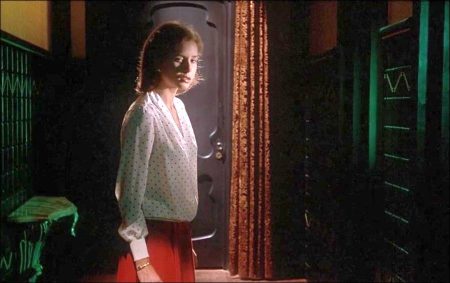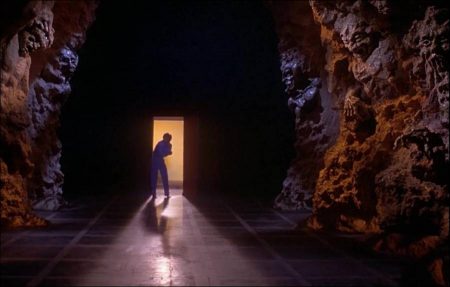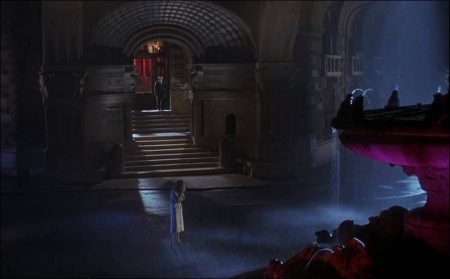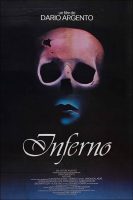Taglines: Before Tenebrae, Beyond Suspiria there is… Inferno!
Inferno movie storyline. Riddled with secret but horrid suspicion, the young American poet, Rose Elliot, writes to her brother and musicology student in Rome, Mark, about the startling findings in the dark and dank basement of her New York Art Deco apartment building.
Pivoting around the cryptic knowledge hidden in the leather-bound book entitled “The Three Mothers”, Rose is convinced that her aristocratic but damned abode is, in fact, an ancient coven for Mater Tenebrarum, the malevolent Mother of Darkness. Little by little, as the siblings delve deeper and deeper into the occult, a mysterious disappearance and an endless string of gruesome killings will bring Mark closer and closer to a surreal nightmare. Where do the long and shadowy corridors of Rose’s building lead?
Inferno is a 1980 Italian supernatural horror film written and directed by Dario Argento. The film stars Irene Miracle, Leigh McCloskey, Eleonora Giorgi, Daria Nicolodi and Alida Valli. The cinematography was by Romano Albani, and Keith Emerson composed the film’s musical score. The plot follows a young man’s investigation into the disappearance of his sister, who had been living in a New York City apartment building that also served as a home for a powerful, centuries-old witch.
A thematic sequel to Suspiria (1977), the film is the second part of Argento’s Three Mothers trilogy. The long-delayed concluding entry, The Mother of Tears, was released in 2007. All three films are partially derived from the concept of “Our Ladies of Sorrow” (Mater Lachrymarum, Mater Suspiriorum and Mater Tenebrarum) originally devised by Thomas de Quincey in his book Suspiria de Profundis (1845).
Unlike Suspiria, Inferno received a very limited theatrical release and the film was unable to match the box office success of its predecessor. While initial critical response was mostly negative, its reputation has improved considerably over the years. Kim Newman has called it “perhaps the most underrated horror movie of the 1980s.” In 2005, the magazine Total Film named Inferno one of the 50 greatest horror films of all time.
Filming, Design and Effects
The filming of Inferno took place mainly on interior studio sets in Rome,[7] but a short amount of time was also set aside for location shooting in New York, including Central Park.[4][7] Sacha Pitoëff’s death scene was filmed on location in Central Park during the summer of 1979. William Lustig, who was credited as the film’s Production Coordinator, recalled,
They filmed the actor carrying a bag that contained some kind of moving mechanism, to make it look like it was full of cats. He walked into the lake, pushed the bag underwater, and fell in. At that point, some phony mechanical rats were attached to him for closeups. When the guy at the hamburger stand runs over the lake… that guy was actually running on a plexiglass bridge under the water; it made it look like he was actually running across the surface of the lake. All of the stuff with the live rats was shot back in Europe.
During the film’s production, Argento became stricken with a severe case of hepatitis—and had to direct some sequences while lying on his back. At one point, the illness became so painful that he was bedridden for a few days; filming was then restricted to second unit work, some of which was done by Mario Bava.[3] Argento has called Inferno one of his least favorite of all his films, as his memories of the movie are tainted by his recollection of the painful illness he suffered.
Argento invited his mentor, Mario Bava, to provide some of the optical effects, matte paintings and trick shots for the film. Some of the cityscape views seen in Inferno were actually tabletop skyscrapers built by Bava out of milk cartons covered with photographs. The apartment building that Rose lived in was in fact only a partial set built in the studio—it was a few floors high and had to be visually augmented with a small sculpture constructed by Bava. This sculpture was set aflame toward the end of production and served as the burning building seen in the climax.
Bava also provided some second unit direction for the production. Maitland McDonagh has suggested that Bava had his hand in the celebrated watery ballroom scene,[4] but that sequence was shot in a water tank by Gianlorenzo Battaglia, without any optical effects work at all. Bava’s son, Lamberto Bava, was the film’s assistant director.
The film’s fiery final sequence was shot without a stunt performer filling in for Leigh McCloskey. After the production’s principal photography had been completed, the film’s producer, Claudio Argento, asked if McCloskey would be willing to perform the stuntwork himself, as the stuntman hired for the job had broken his leg.
The producer assured the actor: “It’ll be absolutely safe”. The actor agreed, and when he walked onto the set the following day he observed “three rows of plexiglass in front of everything and everyone is wearing hard hats. I’m the only guy standing on the other side of this! …Needless to say, I did it all on instinct… I still feel that blast of the door blowing by me. When they tell you in words, its one thing, but when you feel that glass go flying past you with a sound like a Harrier jet, you never forget it!”
Release Information
Inferno was distributed in Italy by 20th Century Fox on February 8, 1980. The film grossed a total of 1,331,763,000 Italian lire domestically. The film had initially promising box office with the films premier in Rome had 500 tickets returned as the venue was packed with audiences even sitting on the floor of the theatre. Overall the film was the 14th highest grossing film in Italy in 1980 and eighth among the highest grossing films of the year.
For reasons never specified, Fox did not commit to a wide theatrical release of Inferno in the United States. In an interview with Maitland McDonagh, Argento speculated that Fox’s decision was made due to an abrupt change in management at the studio that left Inferno and several dozen other films in limbo as a result of them having been greenlighted by the previous management.
The movie sat on the shelf for five years and was released straight to VHS in 1985 via the studio’s Key Video subsidiary. The following year, it had a belated theatrical release by Fox, playing for a one-week engagement in a New York City movie theatre.[16] Worldwide, the film only had a very abbreviated and minimal theatrical release. As noted by Argento, “I think anybody outside of Italy was lucky to see Inferno.” Consequently, Inferno was not a commercial success.
Inferno (1980)
Directed by: Dario Argento
Starring: Eleonora Giorgi, Gabriele Lavia, Veronica Lazar, Leopoldo Mastelloni, Irene Miracle, Daria Nicolodi, Sacha Pitoeff, Alida Valli, Leigh McCloskey, Feodor Chaliapin, Ania Pieroni
Screenplay by: Dario Argento
Production Design by: Andrew W. Garroni
Cinematography by: Romano Albani
Film Editing by: Franco Fraticelli
Costume Design by: Massimo Lentini
Set Decoration by: Francesco Cuppini, Maurizio Garrone
Art Direction by: Giuseppe Bassan
Music by: Keith Emerson
MPAA Rating: None.
Distributed by: 20th Century Fox
Release Date: February 7, 1980 (Italy)
Views: 462



